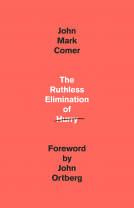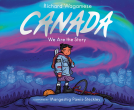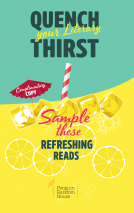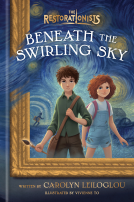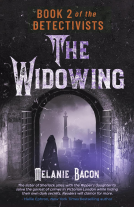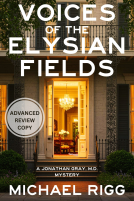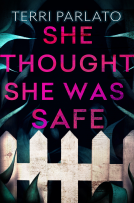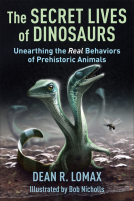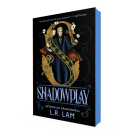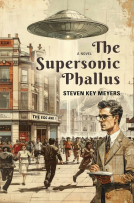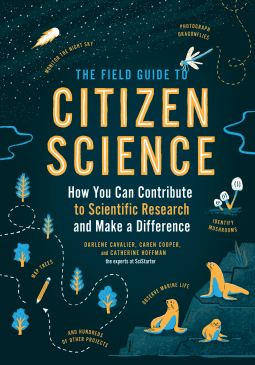
The Field Guide to Citizen Science
How You Can Contribute to Scientific Research and Make a Difference
by Darlene Cavalier; Catherine Hoffman; Caren Cooper
This title was previously available on NetGalley and is now archived.
Send NetGalley books directly to your Kindle or Kindle app
1
To read on a Kindle or Kindle app, please add kindle@netgalley.com as an approved email address to receive files in your Amazon account. Click here for step-by-step instructions.
2
Also find your Kindle email address within your Amazon account, and enter it here.
Pub Date Feb 04 2020 | Archive Date Feb 04 2020
Talking about this book? Use #TheFieldGuideToCitizenScience #NetGalley. More hashtag tips!
Description
Learn how monitoring the night sky, mapping trees, photographing dragonflies, and identifying mushrooms can help save the world.
Citizen science is the public involvement in the discovery of new scientific knowledge. A citizen science project can involve one person or millions of people collaborating towards a common goal. It is an excellent option for anyone looking for ways to get involved and make a difference. The Field Guide to Citizen Science, from the expert team at SciStarter, provides everything you need to get started. You’ll learn what citizen science is, how to succeed and stay motivated when you’re participating in a project, and how the data is used. The fifty included projects, ranging from climate change to Alzheimer’s disease, endangered species to space exploration, mean sure-fire matches for your interests and time. Join the citizen science brigade now and start making a real difference!
Available Editions
| EDITION | Other Format |
| ISBN | 9781604698473 |
| PRICE | $16.95 (USD) |
| PAGES | 188 |
Average rating from 25 members
Featured Reviews
Okay, who took part in SETIhome? Raise your hand... I did for a couple of years and it's in here. I have way too many reading obligations (ARCs and borrowed) but this popped up and I... let myself be sidetracked with this advance review copy received from the publisher from <a href="http://www.netgalley.com">NetGalley</a>, due out in February 2020. Fortunately, it is a very fast read. It comes off targeted to youth/young adults, but Mses. (I know Messrs. is the plural of Mr., but had to look up the plural of Ms.) Cavalier, Hoffman, and Cooper talk early on of "[e]xposing your children to citizen science..."
The authors give “fifty-plus” programs to participate in and they range from things seemingly obvious like bird/animal watching/observing to mushrooms, monarch butterfly migrations, or trash on beaches, Alzheimer’s observations and selfies at streams to help map all of the streams, even reporting infrequent events like landslides. They tell the reader how to find the project, what’s required (simple as a clipboard or a computer, perhaps needing special software or specific collecting materials), how broad the scope is (localized or global), the goal, task, outcome and their opinion why they like the project.
Most importantly, the authors affirm the value of citizen science. You don’t need scientific credentials. You <I>do</I> need to “review all of the instructions, training modules, and information” before beginning. And for it to work...you need to participate. Rightly, the authors advise that the project needs to fit you as much as you fit it. You may not have the time, resources or maybe passion to commit, and we all know sifting bad data is a necessary burden, but responsible limiting of bad data is so, so welcome.
Cringe when reading it moment: An MIT project called DeepMoji is designed to teach Artificial Intelligence systems about emotions, but requires a ... [cringe again as I type this}...<i>Twitter</I> account. Oh, MIT, Twitter? Really? Sifting the sludge, I guess, has some value.
Really cool eye opener when reading it moment: One project (Foldit) has teams solving folding puzzles to help predict protein structures (and gathering data on pattern recognition and general puzzle solving to teach computers how to solve better), used in genetics and drug targeting. The eye-opener./..teams that successfully solve protein folding puzzles become coauthors on the scientific papers!
Five stars for being a novel book on something extremely important, particularly as the US slips backwards on the science front. Check out <a href=“https://scistarter.org/“>SciStarter</a> for more information and opportunities.
 Lynn S, Bookseller
Lynn S, Bookseller
I do Citizen Science with birding groups and was really interested in how many things everyday people can do to help. Anyone who is interested in helping with new discoveries needs to have this book
 Erin L, Librarian
Erin L, Librarian
Highly recommended! Accessible, because so is science! Fun, great for families, teachers, librarians, Girl Scouts, Boy Scouts. Inviting and engaging.
The Field Guide to Citizen Science is well-crafted, featuring an easily accessible layout and a huge selection of ideas to contribute to the worldwide scientific conversation. Many of these projects seem so simple, like they couldn’t possibly make a difference, but the key is the community effort aspect. If millions of individuals take part in these seemingly small acts of science, they can help to predict patterns in viruses and diseases, analyze the effects of mankind’s daily life on the natural world, and potentially help turnaround our harmful effects on the ecosystem. It’s very inspiring to see how many ways people can get involved, and this guide lays it out in an easy-to-read fashion, giving you the play-by-play on making a difference. If you’re looking to take part in something big that could help scientists increase their world reach, this is a great starting point.
NOTE: I was provided a free copy of this book via NetGalley in exchange for my honest, unbiased review.
This is a super cool book. It talks about what citizen science is, how to get involved in a citizen science project, and suggestions of interesting projects with a wide variety of topics and time commitments. This book inspire me to sign up on scistarter.org and join the Stall Catchers project. It's a super interesting introduction to citizen science, that doesn't take long to read.
I received a copy of this book from netgalley in exchange for an honest review.
Surprisingly actionable. I expected (and received) a book with some history and examples of citizen science, everyday citizens contributing data to a variety of scientific studies.
I was impressed by the list of studies currently available to contribute to. From identifying birds and counting bees to sending in soil samples for analysis, the Guide lists options organized by geography and expectations. It also gives sources of more studies you may want to add to.
Looking forward to going through this book with my kids this summer and choosing a study to help with.
**I received a free copy of this eBook from NetGalley in return for an honest review.
 Sharon L, Reviewer
Sharon L, Reviewer
In the age of STEAM, this highly readable title by the SciStarter team of Cavalier, Hoffman, and Coope, has information for anyone who aspires to be a citizen scientist! I had never really thought about it, but a lot of scientists had other professions, and their science discoveries came from their observation during their free time. The authors provide clear advice on how to find programs, how to proceed, how to record and share. There is something for everyone, from the adult who wants to work from home, the hobbyist, schools and teachers, scouts, and library programs.
 Kim C, Educator
Kim C, Educator
Citizen science is becoming way more popular. There are so many places where we can volunteer our time and share our observations with scientists these days. Many of these projects can be done online, which increases the reach and scope of the project. This book tells the reader about how to get involved in some of these projects.
The book is written by the founders of the SciStarter web site. This web site is a place where many of the projects are registered. A citizen scientist can register with the web site, then browse for projects that they are interested in participating in. It makes it much easier and you only have to remember the one login.
The book is broken down into sections. Some of the projects are for particular locations, some are online, some are one-time-only, etc. So, the reader can make choices about which ones they prefer to contribute to. If you don’t know what citizen science is, you can read about it on the web site, or in the book. The book does a great job explaining the basics for anyone who is interested in learning more. And, you don’t have to sign up on the web site. It’s just one option. If you prefer to participate in a project on your own, you can do it through the contact information provided for that project. So, there are a variety of choices as well as projects. They cover a wide array of interests and skill levels.
Each chapter of the book provides details about a particular project. The reader can find out what the scientists are looking for, how to make their observations, how to contribute, and more. The tools needed are also listed, if there are any. I found the accounts very detailed and interesting. There are some sections in the book that give background information as well.
I thought the book was well-organized. It covered the subject quite well and allowed the reader to decide if participation in citizen science is right for them or not. It provides a resource where one can look for projects. It also provides an in-depth look into this fast-growing activity.
Scientists can’t be everywhere. They can only make observations from one place at a time. By allowing everyday people to contribute to research, they are opening up science to all. It’s an experience that anyone can now participate in. Sometimes, you may not even have to leave your home to contribute! How cool is that?
I think this book would be a valuable library resource, and should be in school libraries to encourage students to participate actively in science during their everyday activities. They might grow up to be future scientists!
 Librarian 431790
Librarian 431790
I never heard about Citizen Science before and I was fascinated by this book because I learnt so much.
It was an engrossing and informative read, I enjoyed it and I think it should be read by anyone interested in science.
Highly recommended.
Many thanks to the publisher and Netgalley for this ARC, all opinions are mine.
 Reviewer 602353
Reviewer 602353
I loved this book so much that I just ordered a copy for my dad. I had never even heard of “citizen science” until I saw a friend’s review of this book; but as soon as I understood the concept, I knew I needed participate and get my hands on this book ASAP! (Big thanks to NetGalley and Timber Press for granting me access to the digital ARC). The basic concept is that any willing citizen can help crowdsource data for use in professional scientific research. You don’t need to be college educated or hold any special skills; you just need to be motivated to help. No matter your interests, hobbies, geographic location, or lifestyle, there is probably a project out there that would be a good fit for you. Love long walks on the beach? While you walk count pieces of litter or snap photos of clouds or wildlife to help scientists track trends over time. Prefer the indoors and love history? Help transcribe old war diaries or hand-written letters by people like Shakespeare or Charles Darwin. Or play “video game” simulations to help scientists understand how certain diseases develop. Pregnant and obsessed with everything baby? Join a baby-focused project tracking things like development milestones, sleep patterns, or diaper changes. Want something to do with your kids at home? Collect soil samples, set traps for nocturnal bugs, count ants, or test how different conditions affect the flavor of sour dough bread. Want to *be* the subject? Complete tests for sociological and cognition studies, or report your flu symptoms so that researchers can track clusters of the illness. You get the idea. This concept allows everyday people to be a part of something bigger than them. It bridges the gap between “expert” and “layman.” On a serious note, as someone who is trying to recover from emotional trauma, these projects feel like a way to add meaning to my life, which is exactly what I need right now.
This book was short, but it was a great introduction into citizen science. I've always loved science and wanted to do more, but was unsure how because I don't have a degree in science.. As I was reading this book, I made notes of some of the projects and joined the scistarter website so that I could start getting in on projects immediately. There's so many to choose from and they cover all sorts of categories of science, so there is something that everyone will enjoy. I highly recommend this for anyone who's like me and wants to do more with science but is unsure where to start, or who wants to find more to do with science.
 Diane H, Reviewer
Diane H, Reviewer
“There will always be more unknown than known, more rocks waiting to be overturned.” To be a part-time scientist, you only need a cell phone and the Field Guide to Citizen Science.
SciStarter.org is an online database of more than 1,600 science projects that need help from regular people just like you. But where to start? The dashboard will suggest projects based on your location and interests.
However, if you want a quick start, read the Field Guide to Citizen Science. Projects selected for their popularity, longevity, and diversity are listed within the book in chapters highlighting where they are done (online, at home or in nature). Playing an online game may help cure Alzheimer’s or make you a coauthor of a scientific paper. Each project has a page or two listing the location, website, goal, task, outcomes, and why the authors selected this project.
If you are interested in science, or want to encourage your child to be interested in it, this book is an easy way to see the great variety of citizen science projects that are available. It only takes a minute to sign up. I know because I already became part of the Stall Catchers project that helps find a cure for Alzheimer’s. 4.5 stars rounded up to 5 stars!
Thanks to Timber Press and NetGalley for a copy in exchange for my honest review.
What a great resource to have for families. We homeschool as well as do girl scouts and this book would be a great addition. I loved the layout and the comprehensive list of all the projects you can do. Highly recommend.
 Linda S, Librarian
Linda S, Librarian
THE FIELD GUIDE TO CITIZEN SCIENCE by Darlene Cavalier, Catherine Hoffman, and Caren Cooper is a surprisingly interesting and very engaging book that tells readers "How You Can Contribute to Scientific Research and Make a Difference." There are a variety of projects to do online, at home or in nature, by yourself or through groups, some of which could easily be organized by schools, particularly as we shift to more remote learning. Each project page names a location, provides a website, lists goals, tasks, and outcomes, while also helpfully describing "why we like this." The entire book is worth a look, but a few examples follow. One is Budburst through the Chicago Botanic Garden – which has encouraged participation of over 10,000 citizen scientists to contribute observations on seasonal changes in plants. Another is called Deep Moji which is coordinated by MIT in order to explore emotion research and potentially teach AI about emotions. And a third example is Flu Near You which, like the CDC, tracks the spread of influenza. There is a history element, too, at projects like the Smithsonian’s Transcription Center whose volunteers have transcribed over 380,000 pages of field notes, diaries, manuscripts, etc. since 2013. That is a quick sampling – there are many more ideas!
The authors encourage educators to investigate web sources like the following:
-- SciStarter – they have an Educators’ page and suggested projects by grade level, from elementary school through college.
-- More lesson plans developed with NC State at Students Discover
-- The Cornell Lab of Ornithology
-- And STEM resources from Starnet Libraries (seems particularly slow to load)
Many of the activities are understandably geared to younger students, but it is exciting to see the opportunity to build an interest in science. The authors also recommend several books and viewing public television efforts such as The Crowd and the Cloud or Nature's American Spring Live.
Links to sites mentioned above:
https://scistarter.org/ https://scistarter.com/page/Educators.html
http://studentsdiscover.org/teaching-modules/
https://www.birds.cornell.edu/k12 https://www.starnetlibraries.org/
http://crowdandcloud.org/
https://www.pbs.org/wnet/nature/american-spring-live/
This is a (mostly) easy to read, interesting and informative guide to loading your phone or computer with citizen science apps and carrying out research, then sharing the results.
Maybe this means recording the birds or squirrels you see. Maybe you'll choose to photograph the plastic you find washed up on the beach and upload the photos. You might choose something more esoteric at your desk, like folding shapes to work out possible ways viruses fold proteins. Or identifying plaque in the cells of Alzheimer's patients.
Some of these apps are already on my phone and we're encouraged to sign in to a dashboard so we can collect points and badges, and contribute to a growing community of volunteers. This looks like a great way to spend the summer with kids, and a teacher gives her point of view of a ladybird project in the classroom. College students were asked to record the different species of ants in New York and found an astonishing number, including some which had not been named. Having an eager troop of volunteers who send in sightings and counts makes an invaluable contribution to science.
The book explains which ideas will cost you money for a test kit and which are free, provided you have a smartphone. The book is also a fun read and will encourage those with no science background to get started. The only downside is that most of the apps are American and some do not apply to other nations. However, some like Cornell's E-Bird are globally available.
I downloaded an e-ARC from Net Galley. This is an unbiased review.
 Elizabeth K, Reviewer
Elizabeth K, Reviewer
I wasn't overly familiar with citizen science, and after reading The Field Guide to Citizen Science, I can definitely say that I learned so much about what it is and how accessible it can be.
The book opens on explanations of what citizen science is and a brief but fascinating history of it, which I thought was a great way to kick off a subject that so many people aren't aware of. I know it definitely taught me a lot of background knowledge in a short space, and it gave some great pointers for those starting out.
This field guide provides many examples of types of citizen science, but then it dives into dozens of examples of real citizen science projects that can be joined right away by any readers whose curiosity has been sparked. I have personally signed up for one of the recommended branches of citizen science.
I would definitely recommend this for any person interested in citizen science. It's great for reading from front to back, skimming, or as a reference book. While I believe the book is targeted towards adults, I think many middle-grade and young adult readers will find this to be a helpful resource as well.
For those in isolation due to COVID-19, many of these projects can be done online, in your house, and in your yard.
 Reviewer 550239
Reviewer 550239
This book is incredible! It starts off with a history and description of what citizen science is. Then each section describes different kinds of science you can do. You could read this cover to cover or flip to the section that matches what you want to/can do. It's packed with resources for any science lover and would be the perfect gift for a teen or young adult who is into science.
 Heather D, Bookseller
Heather D, Bookseller
This book inspired me to join one of the sites mentioned. Timely publication. Of particular interest now that many adults and students have much more time available and wonder how to make a contribution to the world during these trying times. Thank you
The coolest thing about the idea of citizen science is that you don't need a fancy degree or PhD in order to provide value to the overall contribution of science. With many of the major scientific discoveries these days relating to the natural world around us there is no reason to go much farther than your own backyard (no matter where in the world you live) in order to help contribute to worldwide scientific findings.
The Field Guide to Citizen Science is beautifully put together. With consistent page layouts and short, easy to understand instructions (along with reasons why the research proposed is important) this daypack sized soft cover book is a lovely gift or addition to any child's library. Using a green and yellow duotone colour scheme it feels more like you are reading a children's textbook than instructions on important, worldwide research.
Additionally at the back is a calendar suggesting which activities to review for each time of the year. It appears to be based on the North American seasonal timeline. This would help a teacher, parent or caretaker find appropriate activities for kids without reading the entire book.
As someone who has helped contribute to Zooniverse, the Gutenburg project, and more; I'm a large advocate of getting kids and adults involved in 'casual science'. Otherwise known as hobby science. Your average telescope buff or astronomer is a hobby scientist. They have the ability to make important breakthroughs; although it's far more likely you will contribute to a larger breakthrough by one of those PhD folks.
A great manual to realize the power of working together in science, and that sharing knowledge is always the best for humankind.
Please note: I received an eARC of this book from the publisher via NetGalley. This is an honest and unbiased review.
 Therese M, Librarian
Therese M, Librarian
I reviewed this book. It is a great book if you are interested as an individual or family in contributing to science. It tells how to go about it and lists projects of all kinds, such as animals, streams, protein folding. The projects can help Alzheimer's research or help decide if a species is disappearing in your area. They talk about how some projects are best for certain type of people like the 9 spotted ladybug project is good for children. I would use the book if I was a science teacher or ran a scouting troop. I also see that this is a good book to use in a senior citizen retirement community to keep minds active. I would recommend this book.
 Reviewer 424805
Reviewer 424805
I loved the consistently engaging voice the author uses, which drew me in and kept me in the book. I also appreciated that it made participating in citizen science more accessible by going so far as to recommend specific projects to get involved with. As much as I enjoyed reading the book, it had a couple weaknesses. Fist, some interesting formatting choices were made in that a random page of body text might just be in a bigger font than the following or preceding pages. As someone with considerable scientific training and with some experience as science educator, I was hoping that it would have more content about starting my own citizen science projects or bringing citizen science to the classroom. Instead, the book is more geared to readers who wish to undertake a personal journey.
Citizen science is a concept that is near and dear to my heart, as to me, science is something that anybody and everybody should have access to. Everyone should be able to contribute and benefit from science. While the term "citizen" is a loaded term, the authors of the book acknowledge that and use it strictly in the sense that the current vernacular uses it, but suggest instead we consider it "community" science.
Science as a field is funded by the public, but that doesn't mean that the public can't contribute to science. And, in fact, local communities tend to know their area better, or have more hands on the ground to collect more data. This book outlines a broad number of different research projects and ways that the average person of any age can contribute to science. Some of the projects require kits to test soil or water, while others only require a smart phone to take pictures. Others are analyzing photos in databases. The variety of projects and potential interests should have anybody interested in at least one project! Each project is presented with a broad over view of the project, what is needed to contribute to the project, the goal, specific tasks, and why the authors of the book like the project. I have personally been involved in several listed in the book (for example, if you haven't checked out https://www.inaturalist.org/ I can't recommend it enough!) This is just a great resource for finding fun projects to do by yourself, with others, or as a community.
*I would like to thank the publisher, author, and NetGalley for providing an ARC copy of this book in exchange for an honest review*
 Librarian 452436
Librarian 452436
This is a wonderful intro to Citizen Science! So much great information! I'm not the most science-minded person, so this helped immensely to get me started on my Citizen Science journey. I have participated in quite a few citsci projects all thanks to this book!
Readers who liked this book also liked:
Dean R. Lomax; Robert Nicholls
Nonfiction (Adult), Outdoors & Nature, Science
